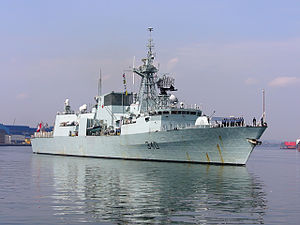
| |
| History | |
|---|---|
| Name | St. John's |
| Namesake | St. John's, Newfoundland and Labrador |
| Builder | Saint John Shipbuilding Ltd., Saint John |
| Laid down | 24 August 1994 |
| Launched | 26 August 1995 |
| Commissioned | 24 June 1996[1] |
| Homeport | CFB Halifax |
| Identification |
|
| Motto | Avancez (Advance) |
| Honours and awards | Arabian Sea[2] |
| Status | In active service |
| Badge |  |
| General characteristics | |
| Class and type | Halifax-class frigate |
| Displacement |
|
| Length | 134.2 m (440.3 ft) |
| Beam | 16.5 m (54.1 ft) |
| Draught | 7.1 m (23.3 ft) |
| Propulsion |
|
| Speed | 30 knots (56 km/h; 35 mph) |
| Range | 9,500 nmi (17,594 km; 10,932 mi) |
| Complement | 245 (including air detachment) |
| Armament |
|
| Aircraft carried | 1 × CH-148 Cyclone |
| Aviation facilities | Hangar and flight deck |
HMCS St. John's (FFH 340) is a Halifax-class frigate that has served in the Canadian Forces and the Royal Canadian Navy since her commissioning in 1996. She is the eleventh of twelve ships in her class which is based on the Canadian Patrol Frigate Project. St. John's is named after the city of St. John's, Newfoundland and Labrador, a port city associated with Canadian naval history and heritage, and is the first ship in the Royal Canadian Navy to bear the name.
St. John's serves on Canadian Armed Forces missions protecting Canada's sovereignty in the Atlantic Ocean and enforcing Canadian laws in its territorial sea and exclusive economic zone. St. John's has been deployed on missions throughout the Atlantic Ocean, to the Indian Ocean; specifically the Persian Gulf and Arabian Sea on anti-terrorism operations, to the north as far as Grise Fiord and to the Caribbean where she played a role in helping to stop the flow of illicit drugs to North America. She is assigned to Maritime Forces Atlantic (MARLANT) and her homeport is in Halifax, Nova Scotia.
- ^ "Official Lineages, Volume 2: Ships". National Defence and the Canadian Forces. 7 July 2006. Retrieved 14 October 2016.
- ^ "South-West Asia Theatre Honours". Prime Minister of Canada. Archived from the original on 12 May 2014. Retrieved 9 May 2014.